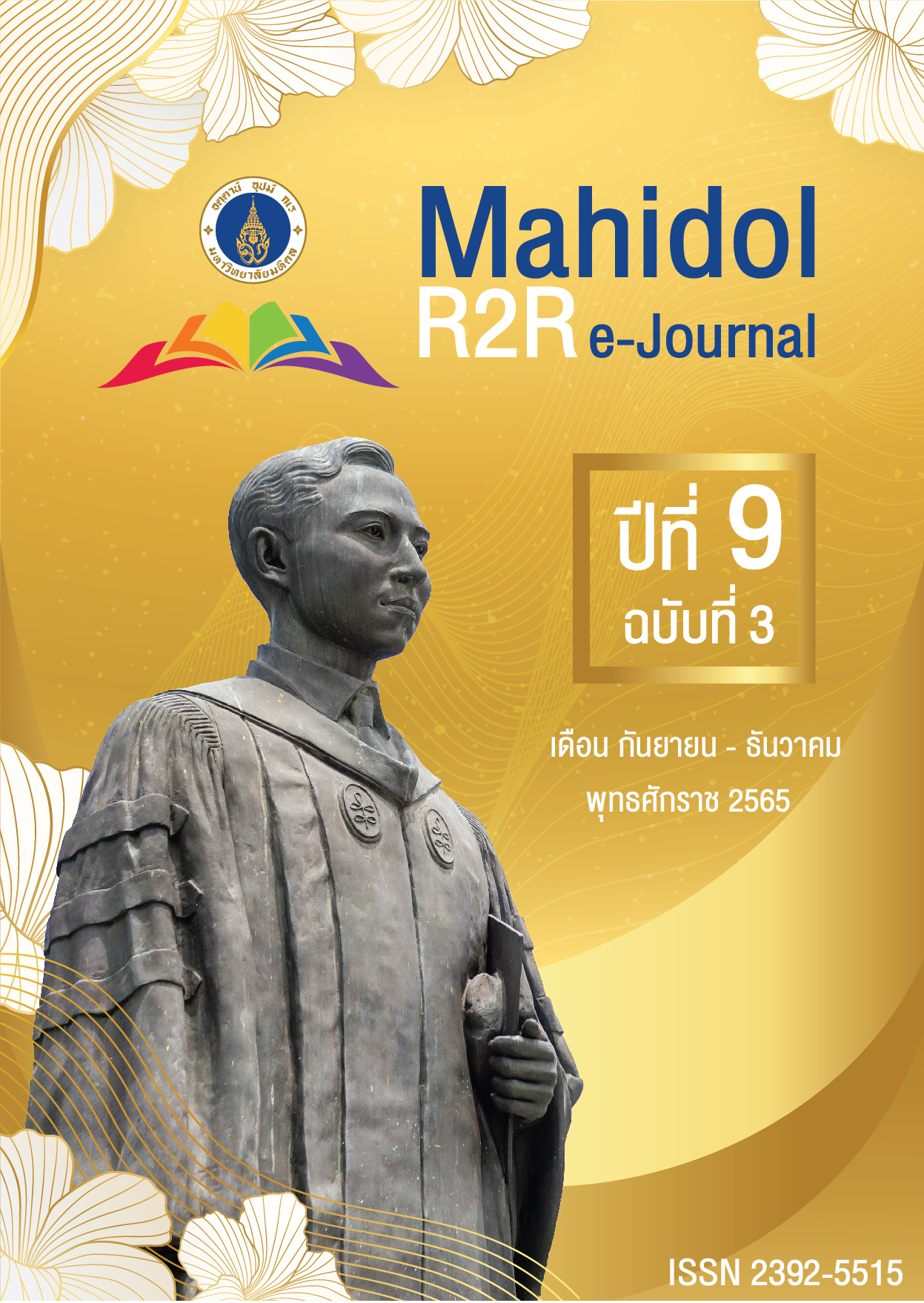ประสิทธิผลการใช้อุปกรณ์ครอบป้องกันทวารเทียมยื่นยาวและไส้เลื่อนข้างทวารเทียม
DOI:
https://doi.org/10.14456/jmu.2022.24คำสำคัญ:
อุปกรณ์ครอบป้องกันทวารเทียม, ทวารเทียมยื่นยาว, ไส้เลื่อนข้างทวารเทียมบทคัดย่อ
วัตถุประสงค์: เพื่อทดสอบประสิทธิภาพของอุปกรณ์ครอบป้องกันทวารเทียม (SP stoma protector) ในการป้องกันภาวะทวารเทียมยื่นยาวและไส้เลื่อนข้างทวารเทียม
วัสดุและวิธีการ: เป็นวิจัยกึ่งทดลอง (แบบศึกษากลุ่มเดียว วัดก่อนและหลัง) โดยใช้อุปกรณ์ครอบป้องกันทวารเทียมต้นแบบซึ่งประกอบด้วย ตัวครอบทวารเทียม และเข็มขัดผ้า ในผู้ป่วย 16 ราย ที่มีภาวะทวารเทียมยื่นยาว เก็บข้อมูลที่โรงพยาบาลมหาวิทยาลัยในภาคใต้ ตั้งแต่มกราคม 2563 ถึงพฤษภาคม 2564 ภาวะทวารเทียมยื่นยาวและไส้เลื่อนข้างทวารเทียมได้รับการประเมินสองครั้งเพื่อเปรียบเทียบประสิทธิภาพ โดยประเมินก่อนที่จะใช้อุปกรณ์ครอบป้องกันทวารเทียมที่คลินิกศัลยกรรม และมีการติดตามผลการใช้ทางโทรศัพท์หลังการใช้ 2-3 วัน
ผลการวิจัย: กลุ่มตัวอย่าง 16 ราย อายุระหว่าง 8-83 ปี (มัธยฐาน 59) ส่วนใหญ่ได้รับการวินิจฉัยว่าเป็นมะเร็งลำไส้ใหญ่ (ร้อยละ 87.5) และมีทวารเทียมแบบลำไส้ไม่ถูกตัดขาดจากกัน (loop stoma) ร้อยละ 81.3 (ในจำนวนนี้ร้อยละ 43.8 มีดัชนีมวลกายมากกว่า 23) ได้รับการผ่าตัดฉุกเฉินร้อยละ 37.5 และมากกว่าครึ่งมีภาวะทวารเทียมยื่นยาวหลังการผ่าตัดน้อยกว่า 90 วัน (ร้อยละ 62.5) หลังจากใช้อุปกรณ์ครอบป้องกันทวารเทียมพบว่า สามารถป้องกันการเกิดภาวะทวารเทียมยื่นยาวและไส้เลื่อนข้างทวารเทียมได้ทุกราย นอกจากนี้กลุ่มตัวอย่างยังรู้สึกพึงพอใจในด้านการออกแบบด้วยค่ามัธยฐานคะแนนสูงสุดคือ 10 คะแนน รองลงมาคือ ใช้งานง่ายและมีคุณภาพ รวมทั้งรู้สึกสุขสบาย (มัธยฐาน = 8.5)
สรุป: อุปกรณ์ครอบป้องกันทวารเทียมมีประสิทธิภาพในการป้องกันภาวะทวารเทียมยื่นยาวและไส้เลื่อนข้างทวารเทียมแม้ใช้ในช่วงเวลาสั้น ใช้งานง่ายและไม่มีผลเสีย แต่การปรับปรุงต่อไปต้องใช้วัสดุที่มีความแข็งแรงทนทานมากขึ้น
เอกสารอ้างอิง
Biesenbach H. (2000). Device for covering an artificial intestine exit, in particular, for persons with prolapse problems comprises a central element which is provided with a depression for limited intestine movements. Germany patent DE19900611C1.
Butler DL. (2009). Early postoperative complications following ostomy surgery. J Wound Ostomy Continence Nurs, 36 (5), 513-519.
Cesare DJ. (1954). Colostomy appliance. (United States patent US2675002A).
Hubbard G, Taylor C, Munro J, et al. (2019). Experiences of support garments following bowel stoma formation: analysis of free-text responses in a cross-sectional survey. BMJ Open Gastro, 6:e000291. doi:10.1136/bmjgast-2019-000291
Kim JT, Kumar RR. (2006). Reoperation for stoma-related complications. Clin Colon Rectal Surg, 19, 207–212.
Krishnamurty DM, Blatnik J, Mutch M. (2017). Stoma complications. Clin Colon Rectal Surg, 30, 193-200.
Malik T, Lee MJ, Harikrishnan AB. (2018). The incidence of stoma related morbidity –a systematic review of randomised controlled trials. Ann R Coll Surg Engl, 100, 501-508.
Murken DR, Bleier JIS. (2019). Ostomy-related complications. Clin Colon Rectal Surg, 32, 176-182.
National Health Security Office. (2019). Outpatient / Inpatient Information (OP individual, OP/ IP e-claim) UC scheme fiscal year 2012-2016.
Ngamjarus C & Chongsuvivatwong V. (2014). n4Studies: sample size and power calculations for iOS. The Royal Golden Jubilee PhD. Program - The Thailand Research Fund & Prince of Songkla University. Songkla: Prince of Songkla University.
Wayne WD. (1995). Biostatistics: a foundation of analysis in the health sciences (6th ed.). Georgia State University. John Wiley & Sons.
Whealin W. (1991). Ostomy appliances. (United States patent US5125917A).
Wongkhan K. (2017 June, 23). Innovative research model (R&D, D&D, AR, R2R). Lecture Documents, Training Project "Create a new generation of researchers" Available from: http:/www.ubu.ac.th/web/files_up/08f2017060214303228.pdf
ดาวน์โหลด
เผยแพร่แล้ว
ฉบับ
ประเภทบทความ
สัญญาอนุญาต
ลิขสิทธิ์ (c) 2022 Mahidol R2R e-Journal

อนุญาตภายใต้เงื่อนไข Creative Commons Attribution-NonCommercial-NoDerivatives 4.0 International License.




